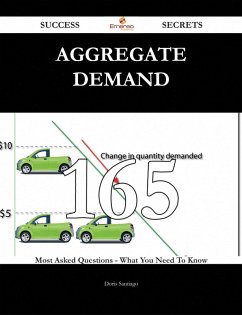An excellent Guide of Aggregate Demand. In macroeconomics, 'aggregate demand' ('AD') is the whole request for ultimate wares and facilities in the financial management at a specified time and cost layer. There has never been a Aggregate Demand Guide like this.
It contains 165 answers, much more than you can imagine; comprehensive answers and extensive details and references, with insights that have never before been offered in print. Get the information you need--fast! This all-embracing guide offers a thorough view of key knowledge and detailed insight. This Guide introduces what you want to know about Aggregate Demand.
A quick look inside of some of the subjects covered: Economic stagnation - Secular stagnation and the Great Recession of 2008-2009, Bank of England - 20th century, List of paradoxes - Economics, Neo-Keynesian economics - IS/LM model (investment saving-liquidity preference money supply), Structural unemployment - Relation to other unemployment, Economy - After World War II, Demand - Demand management in economics, Central Bank - Goals of monetary policy, Labour economics - Neoclassical microeconomic model mdash; Equilibrium, Differences between the Natural Rate of Unemployment and the NAIRU, Stagflation - Neo-Keynesianism, Stagflation - Neoclassical views, Unemployment types, Automatic stabilization, Aggregate demand, Unemployment in the United Kingdom - Economic theory, Economic cycle - Classification by periods, AD-AS model - Effect of monetary expansion on the AD curve, Fiscal policies, Marketing strategies - Types of strategies, Technological unemployment - Views, Luddite fallacy - Views, Debt deflation - Similar theories, Deflation (economics) - Effects, Underconsumption - Theory, Monetary theory - 'Monetary economics' is a branch of economics that provides a framework for analyzing money in its functions as a medium of exchange, store of value, and unit of account. It considers how money, and much more...
It contains 165 answers, much more than you can imagine; comprehensive answers and extensive details and references, with insights that have never before been offered in print. Get the information you need--fast! This all-embracing guide offers a thorough view of key knowledge and detailed insight. This Guide introduces what you want to know about Aggregate Demand.
A quick look inside of some of the subjects covered: Economic stagnation - Secular stagnation and the Great Recession of 2008-2009, Bank of England - 20th century, List of paradoxes - Economics, Neo-Keynesian economics - IS/LM model (investment saving-liquidity preference money supply), Structural unemployment - Relation to other unemployment, Economy - After World War II, Demand - Demand management in economics, Central Bank - Goals of monetary policy, Labour economics - Neoclassical microeconomic model mdash; Equilibrium, Differences between the Natural Rate of Unemployment and the NAIRU, Stagflation - Neo-Keynesianism, Stagflation - Neoclassical views, Unemployment types, Automatic stabilization, Aggregate demand, Unemployment in the United Kingdom - Economic theory, Economic cycle - Classification by periods, AD-AS model - Effect of monetary expansion on the AD curve, Fiscal policies, Marketing strategies - Types of strategies, Technological unemployment - Views, Luddite fallacy - Views, Debt deflation - Similar theories, Deflation (economics) - Effects, Underconsumption - Theory, Monetary theory - 'Monetary economics' is a branch of economics that provides a framework for analyzing money in its functions as a medium of exchange, store of value, and unit of account. It considers how money, and much more...
Dieser Download kann aus rechtlichen Gründen nur mit Rechnungsadresse in A, D ausgeliefert werden.


